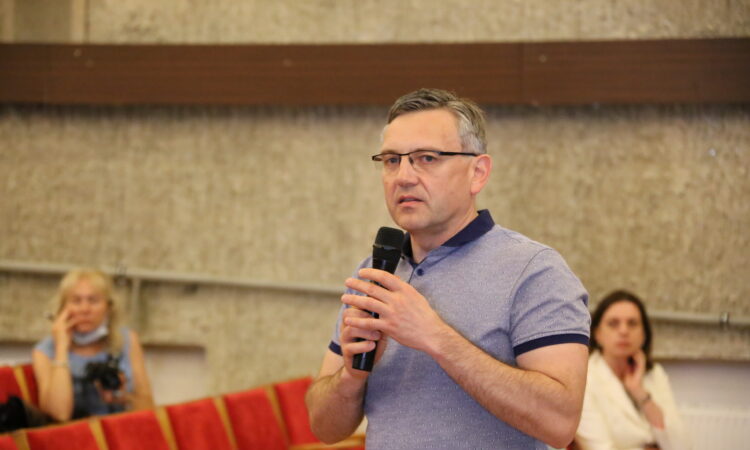Dairy farms around the world are striving to ensure that farm profitability and climate change must go hand in hand. They are also looking responsibly at how to make more efficient use of existing resources, how to make better management decisions and how to protect the environment. Consumers also need to know that they are consuming dairy products produced on farms that are safe and environmentally responsible. Dairy farms are sometimes blamed, quite unjustifiably, for climate change and greenhouse gas emissions of carbon dioxide (CO2) and methane (CH4). More information is needed to change this attitude and to protect dairy farms from the often unfounded attacks. Some people have it and are aware of the situation, while others are guided by emotion and attack dairy farms without justification. In Lithuania, this trend is not yet so pronounced, but there are lessons to be learned from the COVID-19 situation. Education and correct information is the key in all situations that we do not know. So we must raise awareness about the environment and how dairy cattle farming contributes to a safer and more sustainable world. Human sustainability with the environment becomes even more important in the face of COVID-19, as it helps to maintain the social link between producer and consumer and to trust each other.
Let’s first find out which industries are the biggest emitters of heat-trapping gases and why dairy farms are being targeted inappropriately. Again, if we look more closely at the COVID-19 situation, it is in the industrial districts that environmental improvements have been found, even though the number of dairy animals has not decreased. In general, agriculture contributes the least to pollution, but it is often not mentioned that farming also contributes to reducing greenhouse gases.
Sustainable and efficient farming is certainly not a threat to climate change. In Lithuania, the number of farms doing so is growing. On dairy farms, this is facilitated by high-efficiency dairy breeds (Black and Green Holsteins, a small population of Jersey). The more milk an animal produces, the lower the environmental impact. It may sound a bit paradoxical, but the research carried out in France supports this. Of the 3,649 farms that took part in the study, the 333 most productive farms emitted 18% less CO2 per kg of milk than the less efficient farms. Productive farms have higher feed efficiency, a more balanced diet, better manure quality and other important factors such as better grass seed, pasture renovation and maize acreage. It has been estimated that 1 ha of maize on a farm emits enough oxygen to feed 60 people for a year, and that a field of maize the size of a football pitch sequesters as much CO2 as 8-13 cars per year.
I think this makes us look at dairy farms in a different light, namely in terms of their contribution to a safer and cleaner world.
Although the results are promising and point the direction of the farm, dairy cattle still remain at the top of the pyramid according to the 2005 survey. This is because there are many breeds of dairy cattle in the world, but our country can contribute to climate change mitigation through the right choice of breeds, monitoring of feeding, and breeding healthier animals. We also have a shared responsibility to do so, as greenhouse gas emissions are increasing worldwide.
On farms, investments in grass and crop seeds are being made in parallel with efficient milk production. In this way, both the farmer and the consumer benefit. The farmer reduces production costs by using less fuel, pesticides and herbicides, while the consumer gets a safer and healthier product. So, in addition to livestock genetics, the world is investing heavily in seeds for grasses, forage and food crops. The increase in the human population, already 7.7 billion in 2020, encourages us to provide ourselves with safe and healthy food, while at the same time protecting and preserving the environment around us. The growth in livestock productivity over the next 10 years will be faster than the growth in livestock numbers, and the same will be true for cereal crops. These growth trends were presented at the 2019 Dairy Congress in Istanbul. We are also seeing these developments on our own farms.
Cereal crop growth is expected to be very high and pasture areas are even decreasing, although livestock farming intensity is maintained as pasture efficiency increases. Pasture, as modern seed meadows, contributes strongly to a lower increase in greenhouse gases by accumulating huge quantities of CO2.
A few more observations on how dairy farming contributes to a healthier environment. An important factor in the existence of a sustainable and safe dairy farm is the use of antibiotics. Farms that implement innovative herd management programmes based on the use of artificial intelligence in herd management significantly reduce the use of antibiotics. Only sick animals are treated and the effects of antibiotics are tracked in the programmes, thus avoiding the increased use of antibiotics on livestock. The dairy industry is also innovating. In the future, some foreign processing companies are planning to switch to PET recyclable bottles for milk. After all, PET mineral bottles are successfully sold in the Lithuanian taromats.
Dr. Edvardas Gedgaudas

